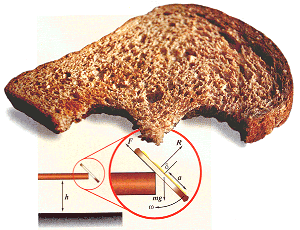
Mathematics |
Missed your copy of the Euro-Journal of Physics last month? Then you might not know that Focus contributor Robert Matthews - wearing his research fellow hat -has been hard at work at Birmingham's Aston University doing some fiendishly difficult sums with his abacus.
The thing that bothered him was why when a piece of buttered toast slips off the plate it almost always lands butter-side down. If you don't believe him, try for yourself. But what has all this to do with maths?
"It all boils down to this," begins Matthews. "When toast falls, gravity makes it start to spin.By plugging values for the properties of toast into the equation, it's possible to calculate the side upwards again by the time it hits the carpet."
The Matthews equations are not unlucky at all, but a natural consequence of gravity acting on the typical of the average breakfast table.
Of course tables are height they are because humans are the size they are. Supposing we were taller: how tall would we have to be to have tables of a height from which toast would fall butter-side up? Matthews did some more sums (you can find them all in the Journal if you're up to it),and concluded that ten feet was the maximum viable height for a two legged creature - any taller and you wouldn't be able to get about safely,and falling over would be fatal.
For a ten-foot human the maximum height of a breakfast table would be about five feet.No one can say from experience -the tallest human ever,Robert Wadlow, was only eight foot 11 - but Matthews has worked out that even a five-foot-high breakfast table wouldn't save the carpet.
"The formula giving the maximum height of humans contains two so-called `fundamental constants of the universe' ," says Matthews."The first determines the strength of the chemical bonds in the skull; the second determines the strength of gravity pulling us over.''The values of these constants were built in to the design of the universe moments after the Big Bang, 15 billion years ago - so there's pieces of toast. Failing that, take breakfast at the top of a very tall ladder so that the toast has time to turn right-side-up again - at least your carpet will stand a chance then.
Matthews's own solution is this: when you see your toast sliding off the table, give it a smart swipe to help it on its way. This canny boost will minimise the time the toast is exposed to the turning effect of gravity.
This weighty research finally lays to rest the popular theory that the "butter-side-down syndrome" is caused by the different aerodynamics of butter and dry toast. "At table height," Matthews says solemnly, toast in hand,"aerodynamics are irrelevant. What counts here is gravity."

The maths of Murphy's law .
Your toast begins to rotate as soon as its centre of gravity moves a distance (d) over the edge of the table.
This spin (angular velocity w) is produced by a torque made up of the weight (mg), reaction at the table edge (R) and frictional force (F).
When it has turned through a small angle (0) the toast lifts off from the table, continuing to turn at w as no force other than gravity is acting on it.
In the time it takes to hit the floor (T), the toast spins wT degrees.
If wT + 0 is less than 270 degrees,the toast lands butter-side down.
Wrong Shui -Use your loaf
If your toast always lands butter side down,plan ahead.
Butter the other side instead.